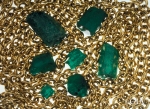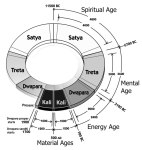 The Ginan Gist – By Karim Maherali. Brief note about the raag (tune) by Aly Sunderji.
The Ginan Gist – By Karim Maherali. Brief note about the raag (tune) by Aly Sunderji.
This Ginan is recited during the partaking of Abe-sifa (Holy Water) and hence is called Ghatpaat no Ubho Ginan (Ghatpaat Standing Ginan). It highlights the importance of keeping the soul constantly refreshed and protected through the proper observance of rites and rituals and ethical conduct and keeping aloof from evil.
atanā sarovar sarāsar bhareā
|
|
Transliteration, Translation and Commentary
| Eji Satna sarovar saraasar bhariya Eva amijal bhariya so aasha jire Eñe sarovariye ho satne sarovariye Hetaaras paar virabhai baandho ji.. ..1 |
O momins! The lake of truth is brimful, and thus the water of life, is also abundant and pure/holy. O dear ones! Maintain(or be in) the lake of this water. Maintain(or be in) this lake of truth and construct the bank of love, o dear brothers!
Comment: There are two ways of interpreting the lake of truth. On the one hand, it signifies the JamatKhana wherein life-giving water comprising of knowledge, wisdom and abe-sifa (holy water) is in abundance. Therefore we must endeavor to be regular in attendance and partake of this water. On the other hand, for an enlightened soul the lake of truth is the elevated soul consciousness filled with sat-chit-anand (truth, correct vision and consciousness, and joy) and one must live by the promptings of this elevated soul awareness all the time. The bank of love (farmanbardari and proper ritual observance with understanding) protects the water of life flowing into the empty desert of materialism.
The Holy Qur’an mentions the soul-purifying aspect of water:
“Remember, when He overwhelmed you with drowsiness [giving] security from Him and sent down upon you from the sky, rain by which to purify you and remove from you the evil [suggestions] of Satan and to make steadfast your hearts and plant firmly thereby your feet.”(8: 11)
| Eji Hansaji-na raaja jyaare jilvaane betha tyaare bagla tado tad naatha jire….Eñe..2 |
O momins! When the swan came on the lake for excursion or a bath, the herons dispersed immediately. O dear ones! Maintain….
Comment: The swan is symbolic of the king of the souls (the Imam) and when the Imam enters the lake (the soul and heart) spiritually and hence granting the benefits of religious practices, the evil tendencies symbolized by the herons, automatically make exit from the soul. The joy of the higher replaces the pleasure of the lower nature.
Holy Qur’an:
“And establish the prayer at the two ends of the day and at the approaches of the night; verily the good deeds remove evil deeds. That is a reminder for the mindful. And be patient (and steadfast); for verily Allah does not waste the reward of the righteous (ones).”(11: 114-115)
| Eji Dharamni laher kaa(n)y jharmar varse Eva amijal varse so aachha jire….Eñe..3 |
O momins! The waves of religion are drizzling. Thus the water of life is pouring in purity(to fill this lake). O dear ones! Maintain…
Comment: The constant drizzling of the water of life signifies the constant and continuous flow of Divine inspiration and peace rendering the souls constantly vigilant and refreshed with coolness and tranquility.
The verse of the Holy Qur’an mentioned in the first verse is also applicable here.
| Eji Saar piyo ne vikhe ras dholo Eva amijal adka piyaasa jire.. ..Eñe..4 |
O momins! Drink the pure and spill off the poison of evil. Crave more and more for this water of life. O dear ones! Maintain…
Comment: When a soul has had a taste of spiritual happiness, it constantly craves for more and more.
Mowlana Sultan Muhammad says in his Memoirs:
“But as the joys of human love surpass all that riches and power may bring a man, so does that greater spiritual love and enlightenment, the fruit of that sublime experience of the direct vision of reality which is God’s gift and grace, surpass all that the finest, truest human love can offer. For that gift we must ever pray.”
Holy Qur’an makes a distinction between pure water of life and poison:
“And not alike are the two bodies of water. One is fresh and sweet, palatable for drinking, and one is salty and bitter.” (35:12)
“O my son, establish prayer, enjoin what is right, forbid what is wrong, and be patient over what befalls you.” (31:17)
| Eji Chaar paaline tame paanchaj vaaro Evi aachhi aachhi karñi kamaavo jire.. ..Eñe..5 |
O momins! Observe the four and discard the five. Thus earn only the good deeds. O dear ones! Maintain…
Comment: This verse is the elaboration of the previous one. It is more specific about what is good and what is evil. The good comprises of the four virtues – sat(truth), saburi(patience), imaan(faith) and zikar(remembrance of the Lord). The evil comprises of the five vices – kaam(carnal desires), krodh(anger), lobh(greed), moh(deep love for this world) and madh(pride).
| Eji Kaam krodh jena ghat maa(n)he jaaher jaagiya Teñe jeetya jeetya daa sarve haarya jire.. ..Eñe..6 |
O momins! The one in whose heart the forces of anger and carnal desires became manifestly awakened, lost all the games that were won previously. O dear ones! Maintain….
Comment: The reference to previous gains alludes to the attainment of this path as a direct result of the gains made due to good actions of the previous births. If a soul is overcome by the dual forces of lust and anger, hence compromising his capacity for spiritual elevation and vision, has indeed lost everything he worked hard for in his previous births.
| Eji Bhañe Pir Sadardin saambhlo gatiyu(n) momano To tame baar karod maa(n)he jheelsho jire.. ..Eñe..7 |
O momins! Peer Sadardeen teaches: O momins of the congregation listen (to and follow what I have said) thereby you will join and enjoy the company of the twelve crores. O dear ones! Maintain…
Comment: Twelve crores refers to the number of souls that were saved by Pir Sadardeen during the age of Kaliyuga. Joining and enjoying with them is an expression of the loftiness of the state of spiritual enlightenment in terms of protection and power.
A brief note about the raag (tune) aspect of the Ginan by Aly Sunderji
 The above ginan is classified as Ghat Paatna Ubha Ginano, to be sung while Aab-e-Safa is being served. The composition is predominantly based in Raag Khamaaj, with a slight usage of Tivr Madhyam (Sharp Ma) in both Aaroh and Avroh (ascending and descending) Raag Khamaaj uses all Shuddh notes other than Komal Nishaad (flat ni) in its avroh notes used are SGMPDNS SnDPMGRS. The traditional samay for this raag is the second prahar of the night (between 9 PM and 12 AM) I thank my colleague Koyal Ansingkar for her help in academic research with regards to the notations of this ginan.
The above ginan is classified as Ghat Paatna Ubha Ginano, to be sung while Aab-e-Safa is being served. The composition is predominantly based in Raag Khamaaj, with a slight usage of Tivr Madhyam (Sharp Ma) in both Aaroh and Avroh (ascending and descending) Raag Khamaaj uses all Shuddh notes other than Komal Nishaad (flat ni) in its avroh notes used are SGMPDNS SnDPMGRS. The traditional samay for this raag is the second prahar of the night (between 9 PM and 12 AM) I thank my colleague Koyal Ansingkar for her help in academic research with regards to the notations of this ginan.
Ginan Series – By Karim Maherali & Aly Sunderji
 Ginan: Saahebjee tu(n) more man bhaave – O Imam! You are dear to my heart (mind) - The Ginan Gist – By Karim Maherali. Brief note about the raag (tune) by Aly… Ginan: Saahebjee tu(n) more man bhaave – O Imam! You are dear to my heart (mind) - The Ginan Gist – By Karim Maherali. Brief note about the raag (tune) by Aly… Ginan: Hu(n) re piyaasi piya tere darshanki – I thirst, o Beloved, for a vision of You - The Ginan Gist – By Karim Maherali. Brief note about the raag (tune) by Aly… Ginan: Hu(n) re piyaasi piya tere darshanki – I thirst, o Beloved, for a vision of You - The Ginan Gist – By Karim Maherali. Brief note about the raag (tune) by Aly… Munaajaat: Ya Aly Khoob mijaalas jeenat karke – O Aly, in the fair assembly gloriously adorned - Munaajaat Gist: By Karim Maherali. Brief note about the raag (tune) by Aly Sunderji. A… Munaajaat: Ya Aly Khoob mijaalas jeenat karke – O Aly, in the fair assembly gloriously adorned - Munaajaat Gist: By Karim Maherali. Brief note about the raag (tune) by Aly Sunderji. A… Ginan: Hetesu(n) milo re munivaro – With love and affection meet, O the best of ascetics - This Ginan highlights the ultimate purpose of our existence: to enjoy the Vision of God Ginan: Hetesu(n) milo re munivaro – With love and affection meet, O the best of ascetics - This Ginan highlights the ultimate purpose of our existence: to enjoy the Vision of God Ginan: Shahnaa khat aayaa viraa Jampudeep maa(n)he – The Imam’s letter has arrived in the Indo-Pakistan subcontinent - This Ginan is called a Talika Ginan. It is recited on the occasion of the reading of Mowlana Hazar Imam's messages to the Jamat Ginan: Shahnaa khat aayaa viraa Jampudeep maa(n)he – The Imam’s letter has arrived in the Indo-Pakistan subcontinent - This Ginan is called a Talika Ginan. It is recited on the occasion of the reading of Mowlana Hazar Imam's messages to the Jamat Ginan: Swaami-ne saachu(n) karine sreviye – By considering the Imam to be true, be devoted to him - This is a lengthy Ginan which covers many aspects of our faith - importance and benefits of following the Imam of the time Ginan: Swaami-ne saachu(n) karine sreviye – By considering the Imam to be true, be devoted to him - This is a lengthy Ginan which covers many aspects of our faith - importance and benefits of following the Imam of the time Ginan: Aaj aanand paamiya man ke – Today this mind (heart) has attained joy - The essential message of this Ginan is to abandon the false worship of the idols. Ginan: Aaj aanand paamiya man ke – Today this mind (heart) has attained joy - The essential message of this Ginan is to abandon the false worship of the idols. Ginan: Unchaa re kot bahu vechana – Your abode is at an elevated fort far away - This Ginan highlights the need to constantly be aware and engage in the quest for the ultimate purpose and meaning which is crowned by the gift of Darshan (Vision) Ginan: Unchaa re kot bahu vechana – Your abode is at an elevated fort far away - This Ginan highlights the need to constantly be aware and engage in the quest for the ultimate purpose and meaning which is crowned by the gift of Darshan (Vision) Ginan: Ham dil khaalak Allah sohi vase ji – My heart is the creation and Allah resides therein - This Ginan highlights the esoteric dimension of our Tariqah with respect to the notion of a Perfect Man as a macrosm of creation in whose heart the entire creation is reflected and in whom the Divine fully manifests and hence expresses the Divine will par excellence. Ginan: Ham dil khaalak Allah sohi vase ji – My heart is the creation and Allah resides therein - This Ginan highlights the esoteric dimension of our Tariqah with respect to the notion of a Perfect Man as a macrosm of creation in whose heart the entire creation is reflected and in whom the Divine fully manifests and hence expresses the Divine will par excellence.  Ginan: Dur desh thee aayo vannjaaro – You have come from a distant country, o travelling trader - This Ginan highlights the transitory nature of our existence in this world by way of the imagery of a travelling trader and that all our actions are dealings with the world and are a means of attaining the ultimate objective of meeting the Imam. Ginan: Dur desh thee aayo vannjaaro – You have come from a distant country, o travelling trader - This Ginan highlights the transitory nature of our existence in this world by way of the imagery of a travelling trader and that all our actions are dealings with the world and are a means of attaining the ultimate objective of meeting the Imam. Ginan: Satna sarovar saraasar bhariya – The Lake of truth is brimful - This Ginan highlights the importance of keeping the soul constantly refreshed and protected through the proper observance of rites and rituals and ethical conduct Ginan: Satna sarovar saraasar bhariya – The Lake of truth is brimful - This Ginan highlights the importance of keeping the soul constantly refreshed and protected through the proper observance of rites and rituals and ethical conduct Ginan: Til bhaar tulannaa – Sesame seed’s weight will be accounted for - This Ginan is about what will happen to the souls when they depart from this world highlighting the nature of accountability and the provisions that one needs to take along with him/her to enjoy the felicity of the hereafter. Ginan: Til bhaar tulannaa – Sesame seed’s weight will be accounted for - This Ginan is about what will happen to the souls when they depart from this world highlighting the nature of accountability and the provisions that one needs to take along with him/her to enjoy the felicity of the hereafter. Ginan: Ek teerath vedhddaa – Admonishing a caravan going for the teerath - The Ginan Gist – By Karim Maherali. Brief note about the raag (tune) by Aly… Ginan: Ek teerath vedhddaa – Admonishing a caravan going for the teerath - The Ginan Gist – By Karim Maherali. Brief note about the raag (tune) by Aly… Ginan: Jaag jaagre tun jaag – Wake up, wake up, o you, wake up - The Ginan Gist – By Karim Maherali This Ginan is about the importance of remaining… Ginan: Jaag jaagre tun jaag – Wake up, wake up, o you, wake up - The Ginan Gist – By Karim Maherali This Ginan is about the importance of remaining… Ginan: Ab teree mohabat lagee – Now I am in love with you - The Ginan Gist – By Karim Maherali This Ginan is an expression of love and… Ginan: Ab teree mohabat lagee – Now I am in love with you - The Ginan Gist – By Karim Maherali This Ginan is an expression of love and… Qasida: Ta Surato Paiwande Jahan Bud Ali Bud – Ali the ever present - The Qasida Gist – By Karim Maherali The Holy Quran (4:174) states: “O mankind! Verily… Qasida: Ta Surato Paiwande Jahan Bud Ali Bud – Ali the ever present - The Qasida Gist – By Karim Maherali The Holy Quran (4:174) states: “O mankind! Verily… Ginan: Navroz naa din sohaamnnaa – On the glorious day of Navroz - Navruz in Persian means a new day. In the Persian calendar it is the New… Ginan: Navroz naa din sohaamnnaa – On the glorious day of Navroz - Navruz in Persian means a new day. In the Persian calendar it is the New… Ginan: Shaamku aavan(n)taa jo kahe – Those who inform about the arrival of the Imam - The Ginan Gist – By Karim Maherali This Ginan is about the uniqueness of the… Ginan: Shaamku aavan(n)taa jo kahe – Those who inform about the arrival of the Imam - The Ginan Gist – By Karim Maherali This Ginan is about the uniqueness of the… Ginan: Kalpat jalpat maayaa e mohee – Mirage-like and false is this illusory existence in which my soul is attached - The Ginan Gist – By Karim Maherali This Ginan is about the nature of our… Ginan: Kalpat jalpat maayaa e mohee – Mirage-like and false is this illusory existence in which my soul is attached - The Ginan Gist – By Karim Maherali This Ginan is about the nature of our… Ginan: Aasmaanee ta(m)bal vaajeeya – The heavenly trumpets have sounded - O momins! The time will move very quickly; a year will seem like ten days and the days will flow swiftly like water: This Ginan is about the significance of spiritual enlightenment in the life of an individual murid. Ginan: Aasmaanee ta(m)bal vaajeeya – The heavenly trumpets have sounded - O momins! The time will move very quickly; a year will seem like ten days and the days will flow swiftly like water: This Ginan is about the significance of spiritual enlightenment in the life of an individual murid. Ginan: Maal khajinaa bohotaj bhariya – Though you may have filled many treasuries with riches - The Ginan Gist – By Karim Maherali This Ginan highlights the illusory and fleeting nature… Ginan: Maal khajinaa bohotaj bhariya – Though you may have filled many treasuries with riches - The Ginan Gist – By Karim Maherali This Ginan highlights the illusory and fleeting nature… Ginan: Saamee tamaaree vaddee maa(n)he – O Lord in your garden - The Ginan Gist – By Karim Maherali This Ginan conveys the vision of creation as… Ginan: Saamee tamaaree vaddee maa(n)he – O Lord in your garden - The Ginan Gist – By Karim Maherali This Ginan conveys the vision of creation as… Ginan: Sakhee maree aatam naa odhaar – O my Friend! O Saviour of my soul - The Ginan Gist – By Karim Maherali The Holy Qur’an States: “We will show them… Ginan: Sakhee maree aatam naa odhaar – O my Friend! O Saviour of my soul - The Ginan Gist – By Karim Maherali The Holy Qur’an States: “We will show them… Ginan: Kesaree see(n)h Sarup Bhulaayo – The saffron colored lion forgot its identity - The Ginan Gist – By Karim Maherali This Ginan is about overcoming the state of… Ginan: Kesaree see(n)h Sarup Bhulaayo – The saffron colored lion forgot its identity - The Ginan Gist – By Karim Maherali This Ginan is about overcoming the state of… Ginan: Kheddo kheddo jemaani naavddi – Sail skillfully in the boat - The Ginan Gist – By Karim Maherali This Ginan depicts the purpose of life by… Ginan: Kheddo kheddo jemaani naavddi – Sail skillfully in the boat - The Ginan Gist – By Karim Maherali This Ginan depicts the purpose of life by… Ginan: Taariye tu taarannhaar Khudavind – O God save us because you are the only saviour - The Ginan Gist – By Karim Maherali According to the Shia interpretation of the verse… Ginan: Taariye tu taarannhaar Khudavind – O God save us because you are the only saviour - The Ginan Gist – By Karim Maherali According to the Shia interpretation of the verse… Ginan: Pahelaa Kartaa Jug Maa(n)he Shaahnaa – In the first age of Karta Lord’s… - The Ginan Gist – By Karim Maherali Our Tariqah being an esoteric tradition which has… Ginan: Pahelaa Kartaa Jug Maa(n)he Shaahnaa – In the first age of Karta Lord’s… - The Ginan Gist – By Karim Maherali Our Tariqah being an esoteric tradition which has… Qasida: Ya Imami Ya Imami – O my Imam, O my Imam - The Qasida Gist – By Karim Maherali This is a Qasida composed in Arabic by ‘Ali… Qasida: Ya Imami Ya Imami – O my Imam, O my Imam - The Qasida Gist – By Karim Maherali This is a Qasida composed in Arabic by ‘Ali… Ginan: Ye mitthaa Muhammad naam – The name Muhammad is sweet - The Ginan Gist – By Karim Maherali The Holy Qur’an provides us with contrasting perspectives… Ginan: Ye mitthaa Muhammad naam – The name Muhammad is sweet - The Ginan Gist – By Karim Maherali The Holy Qur’an provides us with contrasting perspectives… Ginan: Dhan dhan aajno daaddlo – It is an auspicious day today - The Ginan Gist – By Karim Maherali This Ginan is a Khushyally Ginan which is… Ginan: Dhan dhan aajno daaddlo – It is an auspicious day today - The Ginan Gist – By Karim Maherali This Ginan is a Khushyally Ginan which is… Ginan: Aae rahem rahemaan – As Mercy is from you, O Merciful - The Ginan Gist – By Karim Maherali This Ginan is about what it entails to… Ginan: Aae rahem rahemaan – As Mercy is from you, O Merciful - The Ginan Gist – By Karim Maherali This Ginan is about what it entails to… Ginan: Haq to paak tu baadshaah – You are the Truth and the Pure Majestic King - By Karim Maherali The Ginan Gist This Ginan can be considered as the Shia tafsir… Ginan: Haq to paak tu baadshaah – You are the Truth and the Pure Majestic King - By Karim Maherali The Ginan Gist This Ginan can be considered as the Shia tafsir… Ginan: Duniya Sirajine Shaah More – Having created the world my Lord - By Karim Maherali The Ginan Gist This Ginan is about the purpose of creation which… Ginan: Duniya Sirajine Shaah More – Having created the world my Lord - By Karim Maherali The Ginan Gist This Ginan is about the purpose of creation which… Ginan: Gat maa(n)he aavine – Having come to the congregation - In this third Ginan of the series, Karim Maherali shares the translation with commentary of… Ginan: Gat maa(n)he aavine – Having come to the congregation - In this third Ginan of the series, Karim Maherali shares the translation with commentary of… Qasida: Dur ze daryayi haqiqat – The pearl of the ocean of truth - Karim Maherali shares his insights and knowledge interpreting Nasir Khusraw’s Qasida: Dur ze daryayi haqiqat,… Qasida: Dur ze daryayi haqiqat – The pearl of the ocean of truth - Karim Maherali shares his insights and knowledge interpreting Nasir Khusraw’s Qasida: Dur ze daryayi haqiqat,… Ginan: Aanand aanand kariyo rikhisaro – Rejoice, rejoice o believers! - In this second Ginan of the series, Karim Maherali shares the translation with insight, corroborating… Ginan: Aanand aanand kariyo rikhisaro – Rejoice, rejoice o believers! - In this second Ginan of the series, Karim Maherali shares the translation with insight, corroborating… Ginan: Ginan bolo re nit – Recite Ginans everyday! - Ismailimail in collaboration with Karim Maherali launches a Ginan series which will contain a transliteration… Ginan: Ginan bolo re nit – Recite Ginans everyday! - Ismailimail in collaboration with Karim Maherali launches a Ginan series which will contain a transliteration… Ginans: Our Wonderful Tradition – Ismailimail launches a new series - Ismailimail in collaboration with the alumni of the IIS Karim Maherali, launches a new weekly… Ginans: Our Wonderful Tradition – Ismailimail launches a new series - Ismailimail in collaboration with the alumni of the IIS Karim Maherali, launches a new weekly… Abdulsultan Maherali: Ginan in the presence of Mawlana Hazar Imam - Upon becoming the Imam, Mawlana Hazar Imam took a year off from Harvard where he… Abdulsultan Maherali: Ginan in the presence of Mawlana Hazar Imam - Upon becoming the Imam, Mawlana Hazar Imam took a year off from Harvard where he… |
Previously on Ismailimail…







